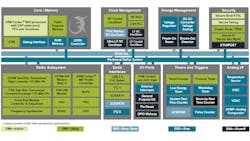Sub-GHz SoC Ready to Take On Smart-City and Long-Range Deployments
Wi-SUN is often touted as the low-power, mesh-network protocol that’ll underlie smart-city IoT implementations. Wi-SUN field-area networks (FANs) are highly robust solutions that support a range of data-rate options with scalability, security, and interoperability. They’re also self-forming, self-healing networks that can handle thousands of nodes in the face of disrupting events such as storms, cyberattacks, and/or power-usage constraints.
In efforts to bolster its Wi-SUN portfolio, Silicon Labs last year announced its EFR32FG25 sub-GHz wireless systems-on-chips (SoCs), which the company claims as a superior solution for long-range, low-power transmissions. Now widely available, the FG25 SoCs are able to broadcast up to 3 km with minimal data loss in dense, urban canyon environments when coupled with SiLabs’ forthcoming EFF01 front-end module.
In addition, the FG25 is the first of SiLabs’ SoCs to support the orthogonal frequency-division multiplexing (OFDM) modulation schemes introduced in Wi-SUN FAN 1.1. OFDM supports highly efficient modulation with data bandwidths of up to 3.6 Mb/s. Thanks to the higher data rates, the FG25 SoC enables the large networks needed by smart cities where the nodes can number in the thousands. The device also is now certified by the Wi-SUN Alliance for the PHY layer of the FAN 1.1 profile, which lessens the burden placed on designers as they design Wi-SUN FAN 1.1-compliant devices.
As an example of the FG25’s utility in large-scale smart-city rollouts, Landis+Gyr adopted the device for use in smart meters. With the FG25, Landis+Gyr has a device that offers more random-access memory (RAM) than SiLabs' FG12, which it had been designing into its meters. The company also needed a means of implementing OFDM schemes, which the FG25 offers, too. Integrating both the MCU and transceiver on the same SoC, the FG25 uses the same form factor as Landis+Gyr’s existing module, making it easier to integrate the new device.


